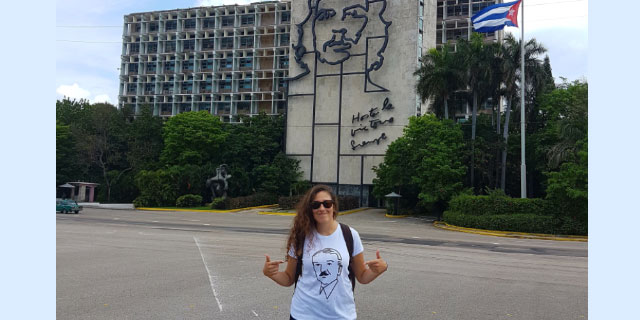Without ever having been to Cuba, many people think of the island as a tropical paradise. Some see it as a time machine, with old cobbled streets, colorful buildings, old forts, and antique cars from bygone eras. Others believe that its crystal clear water, soft sandy beaches, and Caribbean island vibes make for the perfect vacation destination. At least, this is the picture Cuban postcards paint. As can often be the case with advertising, the truth is much different.
While Havana’s historical center might look like the perfect tropical city, the charm wears off after a couple of blocks. Blocks of busy hotels mask the conspicuous absence of actual Cuban residents in the core. A short walk outside the inner historical center reveals that most of the buildings are only façades hiding a ruined interior.
This is a more accurate picture of Cuba: a Potemkin postcard masking the island’s abandonment, poverty, and oppression.
The warning signs start as soon as you step off of the plane: immigration checks whether you are a person the state is controlling. After leaving the airport, it only goes downhill from there. Billboards lining the streets from the airport to Havana make it obvious you are entering a socialist country. Some of them present adoring pictures of Che Guevara. Others characterize the US embargo as genocide. You see tributes to other authoritarian socialist leaders like Hugo Chavez. Every other sign proclaims the greatness of the Communist Party.
After the sideshow of communist propaganda, one finds the real Havana—the Havana of dilapidated streets and trash; the Havana of foul smells and piles of garbage resulting from the state’s lackadaisical maintenance of the once-proud city. The buildings—beautiful colonial and Art Deco relics—sit in disrepair, each crack reflecting Cuba’s growing poverty and neglect.
Then come the signs of scarcity. Food stores and supermarkets are filled with rows of empty shelves. If a lucky store happens to have something in stock, it is most likely rows and rows of the same product, such as “galletas saladas” (saltine crackers). Trying to find specific products, like mushrooms, is impossible. If you set a goal to look for a product, you might have to roam throughout the city to find it. The few stores that stock the standard products one might easily find in the United States or Guatemala (like razors!), sell them at prices most Cubans cannot afford. Most Cubans live on an average of $8 a month—the price of two piña coladas!
When you start interacting with the Cuban people you realize that the basic liberties many residents of other Caribbean islands take for granted are non-existent. Cubans are still afraid to speak about politics because of the repercussions for making politically incorrect comments. There is no right to disagree with with the government. Disparaging the Castro regime in even the most superficial way could result in years of incarceration and forced labor.
State ownership of all newspapers and radio stations disposes of any form of freedom of the press. News is strictly limited to internal affairs, with some praise of Cuba’s new financial backer, Venezuela. The international 8:00 PM news broadcast is strictly limited to Cuba’s allies—a who’s who of authoritarian states, including Venezuela, Vietnam, China, Russia, and Laos. Other than that, international news focuses heavily on shootings and other chaotic events in the United States. Censorship of books, movies, and music in the island prevents the introduction of any other outside information.
The abandonment, poverty, and oppression have impressed themselves upon the personality of many Cubans in a tragic way. It comes up in day-to-day conversations. Many Cubans lack hope for the future; they believe that no matter what they do, their lives are unlikely to improve. Many Cubans are forced to build their lives around trivial concerns: playing dominoes, chitchatting, and sitting around waiting for something—anything—to change. Their right to speak, question, and discuss important ideas has been stripped by the Communist Party of Cuba. Their property and ambition have been expropriated by the state.
Despite its picturesque setting, Cuba is a dark place: her once beautiful towns dilapidated and ruined, her once ambitious people impoverished and disenchanted, her once vibrant culture constrained and controlled. Whatever postcard reality may have existed on the island was ripped to shreds in the 50 years following the Cuban Revolution. And yet for some Cubans at least there remains hope: many are tired of the country’s political and economic backwardness. When you leave the state-run theater of the historic center, one hears whispers of change on the streets of Havana.

